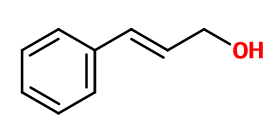Cinnamyl Alcohol
Naturelle - Synthétique
Spicy > Warm Spices > Cinnamic > White Flowers > Honeyed

Crédits photo: ScenTree SAS
Other names :
Styrone® ; 3-phenylprop-2-en-1-ol ; Cinnamic Alcohol ; 3-phenyl allyl alcohol ; Styryl carbinol
Volatility :
Heart/Base
Uses in perfumery :
Cinnamyl Alcohol is suitable for ambery and solar flowers notes. Brings a cinnamon facet that is both warm and spicy. Very good fixator.
Natural availability :
Cinnamyl Alcohol is naturally present in Ceylon Cinnamon EO (and other origins), Peru Balsam Resinoid and Tolu Balsam Resinoid, from which it can be extracted by fractional distillation.
Year of discovery :
1881
Other comments :
Cinnamyl Alcohol is less powerful, heady and warm than Cinnamaldehyde. Cinnamyl Alcohol is one of the 26 allergens in perfumery.
Price Range :
€€
Stability :
Most of the time, the occurrence of a benzenic cycle in a molecule causes a coloration of this molecule through time

Crédits photo: ScenTree SAS
- Molecular formula :
- C9H10O
- Molecular Weight :
- 134,17 g/mol
- Density :
- 1,044
- Flash Point :
- 126°C
- Fusion Point :
- 32°C
- Appearance :
- Colorless liquid that crystallizes at room temperature
- Log P :
- 1,64
- Boiling Point :
- 250°C
- Detection Threshold :
- Le seuil de détection de cette molécule n'est pas le même pour sa forme cis (81 ppb) et sa forme trans (2,8 ppm), Le seuil de détection du mélange des deux est de l'ordre de 1 ppm (0,00001%),
Synthesis route :
Cinnamyl Alcohol is synthesized by a reduction of Cinnamaldehyde, the major component of cinnamon essential oil. This can be done in three ways. The Meerwein-Ponndorf reduction (85% yield) reduces the aldehyde in the presence of Benzyl or Isopropyl Alcohol and their aluminum alkoxide. A second reduction is made with a yield of 95%, in the presence of osmium tetroxide. Finally, a last reduction can be made from Cinnamaldehyde in the presence of sodium tetrahydruroborate.
Synthesis precursor :
Cinnamyl Alcohol is a precursor to the synthesis of cinnamyl esters, such as Cinnamyl acetate or Cinnamyl Benzoate, which are used in perfumery.
Isomerism :
Cinnamyl Alcohol exists as two diastereomers naturally present in nature: the (E) trans form is the most abundant in nature and can be extracted from many plants such as Styrax EO. Cis form is much more powerful (see Other Comments).
Ethyl Vanillin is a constitutional isomer of Cinnamyl Alcohol, although their smell is different as Cinnamyl Alcohol is much spicier and less sweet.
- EINECS number :
- 203-212-3
- FEMA number :
- 2294
- JECFA number :
- 647
- FLAVIS number :
- 02.017
- Allergens :
- Cinnamyl Alcohol may provoke an allergic reaction on skin contact (redness, heat, scraching, prickling) for some people.
- IFRA :
- This ingredient is restricted by IFRA
- Restriction type :
- RESTRICTION
- Cause of restriction :
- DERMAL SENSITIZATION AND SYSTEMIC TOXICITY
- Amendment :
- 49
- Quantitative limit on the use :
-
Cat.1 Cat.2 Cat.3 Cat.4 Cat.5A Cat.5B Cat.5C Cat.5D Cat.6 0,22 % 0,067 % 0,25 % 1,2 % 0,32 % 0,25 % 0,25 % 0,085 % 0,13 % Cat.7A Cat.7B Cat.8 Cat.9 Cat.10A Cat.10B Cat.11A Cat.11B Cat.12 0,25 % 0,25 % 0,085 % 0,76 % 0,76 % 2 % 0,085 % 0,085 % 51 % - Restriction type :
- RESTRICTION QRA
- Cause of restriction :
- SENSITIZATION
- Amendment :
- 43
- Quantitative usage limits :
-
Cat.1 Cat.2 Cat.3 Cat.4 Cat.5 Cat.6 Cat.7 Cat.8 Cat.9 Cat.10 Cat.11 0,09 % 0,1 % 0,4 % 0,4 % 0,4 % 2,2 % 0,2 % 0,4 % 0,4 % 0,4 % Not Restricted
To learn more about IFRA's standards : https://ifrafragrance.org/safe-use/library
ScenTree is solely responsible for the information provided here.


